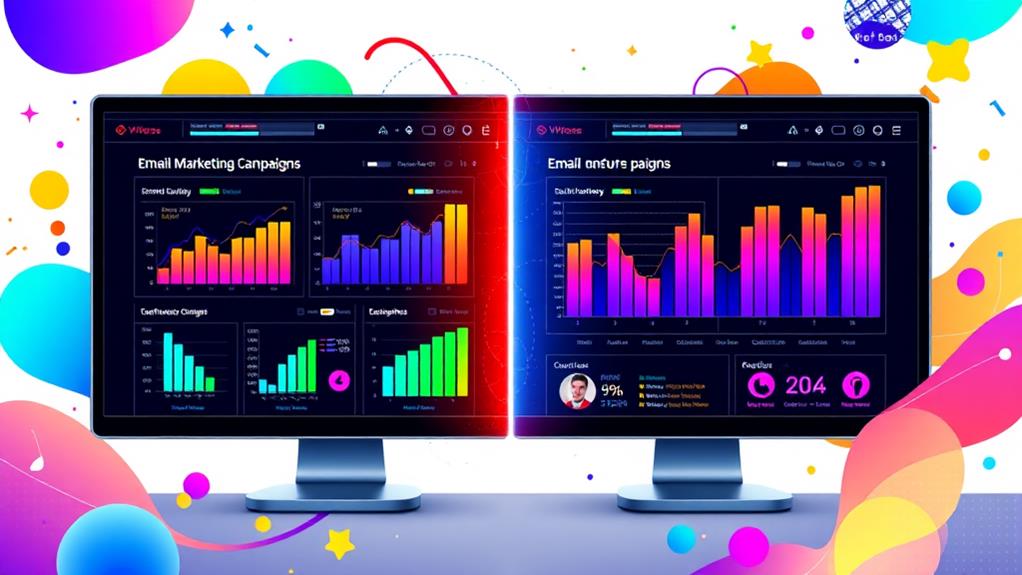Improving email list quality is essential for boosting engagement and conversion rates, elevating marketing performance. Utilize double opt-in methods to increase accuracy and engagement by up to 50%. Regularly clean your list every 6-12 months to maintain positive deliverability metrics, and segment your audience to refine targeting efforts, which can increase revenue by 760%. Guarantee compliance with GDPR and CAN-SPAM regulations to foster trust. Craft personalized and interactive content to enhance open rates by 26%, and re-engage inactive subscribers to reignite interest. Equip yourself with strategies that provide insights into sustaining and growing a high-quality email list.
Key Takeaways
- Implement double opt-in to ensure valid entries and boost engagement rates by up to 50%.
- Regularly clean your email list every 6-12 months to enhance deliverability and engagement.
- Use audience segmentation to tailor content, leading to a 760% increase in campaign revenue.
- Monitor engagement metrics like open and click-through rates to identify necessary list maintenance.
- Ensure compliance with GDPR and CAN-SPAM to build subscriber trust and protect your brand reputation.
Importance of Email List Quality
The significance of email list quality cannot be overstated, as high-caliber lists of engaged subscribers are the linchpins of successful email marketing strategies. Engaged subscribers can lead to conversion rates that are 3-5 times higher compared to less engaged lists. This underscores the vital importance of prioritizing quality over sheer quantity in email list management.
A high-quality list guarantees relevant audiences, enhancing message targeting and personalization, which in turn boosts open and click-through rates—key metrics for gauging campaign effectiveness.
Maintaining a superior email list not only boosts sender reputation but also improves email deliverability, reducing the risk of messages being marked as spam. This is essential for guaranteeing that communications reach the intended inboxes.
Moreover, fostering long-term relationships with subscribers builds brand loyalty and advocacy, emphasizing the need to nurture a quality list for enduring marketing success.
In today's regulatory environment, compliance with standards such as GDPR and CAN-SPAM is vital. Adhering to these regulations safeguards data privacy and bolsters subscriber trust.
This compliance is not only a legal obligation but also a strategic advantage, reinforcing the importance of maintaining a high-quality email list.
Implement Double Opt-In
Implementing a double opt-in process can serve as a strategic linchpin for improving email list quality. By requiring subscribers to confirm their email addresses post-signup, this method considerably reduces invalid entries and raises list accuracy.
Data indicates that double opt-in lists boast up to 50% higher engagement rates, as they capture audiences genuinely interested in the content. This approach aligns with best practices, creating a robust subscriber experience that minimizes spam complaints and unsubscribes.
The double opt-in mechanism offers several strategic advantages:
- Enhanced Engagement: Subscribers who confirm their interest are more likely to engage with content, driving higher open and click-through rates.
- Improved Deliverability: By ensuring subscriber authenticity, double opt-in boosts sender reputation, resulting in better inbox placement.
- Reduced Spam Complaints: Explicit confirmations mean fewer unsolicited emails, lowering the risk of being marked as spam.
- Stronger Brand Relationships: Confirmed subscribers foster trust and loyalty, as they are more inclined to value and interact with brand communications.
- Accuracy and Validation: Double opt-in verifies email addresses, reducing bounce rates and maintaining list integrity.
Regular List Cleaning
To maintain a high-performing email list, it is essential to implement a strategic cleaning routine, focusing on removing inactive subscribers and verifying email addresses.
Evidence suggests that regular list maintenance every 6-12 months can greatly enhance deliverability and engagement metrics by ensuring you target an active audience.
Remove Inactive Subscribers
In the domain of email marketing, pruning your list by removing inactive subscribers is akin to weeding a garden—vital for a thriving ecosystem. Regular list cleaning strategies are important for optimizing subscriber metrics and ensuring that your marketing efforts target an engaged audience.
Studies indicate that lists with fewer inactive addresses see improved open and click-through rates. By focusing on subscribers who haven't engaged for six months to a year, marketers can maintain a more responsive audience.
Implementing an automatic cleaning process, such as monthly or quarterly reviews, can greatly benefit your email list's health. This proactive approach reduces the risk of being flagged as spam and helps maintain a positive sender reputation.
Consider these strategic insights:
- Identify engagement metrics: Determine which subscribers to remove based on open rates and click-throughs.
- Automate the process: Schedule regular list cleanings to streamline operations.
- Monitor bounce rates: High rates, often around 30% for inactive users, can harm deliverability.
- Focus on active subscribers: Cultivating engaged users leads to better conversion rates and relationships.
- Re-engagement campaigns: Before removal, attempt to re-engage dormant subscribers.
A well-maintained list fosters a more engaged audience, ultimately enhancing conversion rates and long-term subscriber relationships.
Verify Email Addresses
Verifying email addresses is a strategic move that can greatly enhance the quality of your email list and improve deliverability rates by up to 20%. By employing effective email validation techniques, businesses can considerably reduce bounce rates, which typically hover around 2% for lists that undergo regular cleaning.
Verification tools play a vital role in this process, enabling you to confirm email addresses at sign-up and identify errors that could otherwise lead to undelivered messages.
Incorporating email validation techniques into your list management strategy not only guarantees that your messages reach intended recipients but also safeguards your sender reputation. A poor sender reputation can result in approximately 20% of emails being marked as spam.
By maintaining a clean list, you protect your communication channels and foster better relationships with your subscribers.
Moreover, regular email list cleaning contributes to increased engagement metrics. By removing invalid or inactive addresses, businesses can achieve engagement increases of about 30%.
This, in turn, leads to a more focused audience and boosts conversion rates by 10-15%. Ultimately, verifying email addresses is an essential practice for any organization looking to optimize its email marketing strategy effectively.
Optimize Engagement Metrics
Optimizing engagement metrics through regular list cleaning is a strategic approach that can greatly enhance the performance of your email campaigns. By focusing on active recipients, marketers can achieve higher open and click-through rates, reducing the 20% decrease in deliverability often caused by inactive addresses.
Implementing a sunset policy to remove unengaged subscribers after a set period, such as six months, preserves list health and guarantees that marketing efforts are targeted towards genuinely interested individuals.
To maximize engagement, it's essential to monitor key metrics like open and click-through rates to determine when list cleaning is necessary. This practice not only improves sender reputation but also boosts inbox placement, increasing the likelihood of engagement.
Employing A/B testing on subject lines, experimenting with email frequency, and exploring various content formats can further refine and optimize engagement strategies.
- A/B testing helps identify the most effective subject lines for engagement.
- Sunset policies streamline the removal of unengaged subscribers, enhancing list quality.
- Monitoring open and click-through rates aids in identifying underperforming segments.
- Adjusting email frequency can prevent subscriber fatigue and boost interest.
- Diverse content formats cater to different recipient preferences, enhancing engagement.
Clear Unsubscribe Options
Ensuring that subscribers can easily opt-out of your email communications is not only a courtesy but a strategic imperative for maintaining a healthy email list. Implementing unsubscribe best practices fosters subscriber trust and enhances transparency. By providing a clear and accessible unsubscribe link, usually placed in the email footer, you minimize disruption to the content while ensuring visibility. This simple action can greatly reduce spam complaints, thereby improving your sender reputation and email deliverability.
Research underscores that a seamless unsubscribe process positively impacts retention rates. Engaged subscribers, when given a straightforward opt-out option, are often more inclined to stay on the list, reconsidering their decision to unsubscribe. Regularly analyzing unsubscribe rates can yield valuable insights into subscriber preferences, allowing for strategic refinements in email content that resonate more effectively with your audience's interests.
| Unsubscribe Element | Impact on Email Strategy |
|---|---|
| Clear Link Placement | Reduces Spam Complaints |
| Easy Opt-Out Process | Enhances Subscriber Retention |
| Data Analysis | Informs Content Refinement |
Ultimately, maintaining an open channel for opt-out not only builds trust but also serves as a feedback mechanism, aligning your email strategy with subscriber expectations.
Audience Segmentation
With the strategic implementation of audience segmentation, marketers can greatly enhance the effectiveness of their email campaigns. By utilizing behavioral targeting and demographic analysis, businesses can craft messages that resonate with specific groups, resulting in a 14% higher open rate and a 10% higher click-through rate compared to non-segmented emails.
Effective segmentation involves categorizing email lists based on various factors such as demographics, interests, and engagement levels, which in turn leads to increased subscriber satisfaction and loyalty.
The financial impact is substantial, with segmented campaigns driving a remarkable 760% increase in revenue, underscoring the importance of targeted messaging over generic approaches. Additionally, regular analysis of engagement metrics within these segments enables marketers to identify which groups respond best to particular content, allowing for the continuous optimization of email strategies.
This method not only boosts revenue but also reduces unsubscribe rates by up to 20%, as subscribers receive content aligned with their specific interests and needs.
Key strategies for effective audience segmentation include:
- Utilizing behavioral targeting to customize content
- Conducting detailed demographic analysis
- Analyzing engagement metrics for ongoing optimization
- Tailoring content based on subscriber interests
- Continuously refining segments for improved targeting
Craft Engaging Content
To enhance email list quality, crafting content that resonates with subscribers is paramount, as personalized emails can achieve a 26% higher open rate.
Incorporating interactive elements like polls or quizzes further amplifies engagement, generating twice the interaction compared to static content.
Personalize for Maximum Impact
Personalization drives engagement and revenue by transforming generic emails into tailored experiences that resonate with subscribers. By leveraging dynamic content and behavioral triggers, businesses can notably boost open rates by 26% and drive an impressive 760% increase in revenue.
Segmenting email lists based on demographics and engagement levels enables more relevant messaging, which enhances click-through rates and overall performance.
To optimize personalization strategies, consider these key practices:
- Incorporate Recipient Data: Use names and preferences in subject lines and body content to increase engagement. Personalization in subject lines alone can enhance open rates by 50%.
- Leverage Customer Data: Develop targeted campaigns that recommend products based on past purchases, thereby driving conversions and fostering long-term subscriber relationships.
- Segment Effectively: Create segments based on demographics and engagement to tailor content that aligns with different subscriber needs and interests.
- Analyze Engagement Metrics: Regularly review open and click-through rates to refine personalization tactics and guarantee alignment with subscriber behaviors.
- Utilize Behavioral Triggers: Deploy automated emails triggered by subscriber actions, such as browsing history or previous interactions, to deliver timely and relevant content.
Implementing these strategies enhances the impact of email campaigns, guaranteeing content resonates with subscribers and driving better results.
Utilize Interactive Elements
Incorporating interactive elements into email campaigns is a strategic method to enhance subscriber engagement and foster a more dynamic connection with your audience. By integrating polling strategies, you can encourage active participation, making subscribers feel valued and more connected to your content. This approach not only boosts engagement rates but also provides valuable insights into subscriber preferences.
Additionally, emails with interactive elements such as animations or countdown timers can increase click-through rates by up to 300%, instilling a sense of urgency and excitement.
Employing gamification techniques, like quizzes or contests, can markedly enrich the user experience. These elements not only entertain but also motivate subscribers to share emails with their networks, thereby broadening your reach. Including clear calls-to-action (CTAs) within these interactive features is essential, as they guide subscribers toward the next steps, thereby enhancing conversion rates.
Moreover, personalizing interactive content based on subscriber behavior and preferences leads to higher engagement. Tailored experiences resonate more deeply, prompting subscribers to interact more frequently.
Monitor Engagement Metrics
Understanding and monitoring engagement metrics is a strategic cornerstone in optimizing email list quality and campaign effectiveness. Employing robust engagement strategies and metric analysis allows marketers to gauge the pulse of their audience and refine their outreach.
Key metrics such as open rates, click-through rates (CTR), and unsubscribe rates serve as crucial indicators of subscriber interest and content relevance. A compelling study underscores the potential of segmented campaigns, which can yield a 760% increase in revenue, highlighting the importance of tailoring content through informed analysis.
By systematically tracking bounce rates, marketers can pinpoint issues with email addresses that may harm deliverability and sender reputation. Regular assessment of engagement metrics also facilitates the identification of inactive subscribers, paving the way for targeted re-engagement initiatives.
Additionally, A/B testing emerges as a powerful tool, enabling marketers to dissect and improve various email components like subject lines and CTAs for enhanced engagement.
- Open Rates: Monitor to understand initial interest.
- Click-Through Rates (CTR): Analyze to gauge content effectiveness.
- Unsubscribe Rates: Track to identify content dissatisfaction.
- Bounce Rates: Evaluate to maintain sender reputation.
- A/B Testing: Utilize for data-driven content refinement.
Ensure Compliance With Regulations
Maneuvering the complex landscape of email marketing regulations is vital for maintaining a high-quality email list and protecting your brand's reputation. Compliance with data protection laws like GDPR and CAN-SPAM is not only a legal obligation but also a strategic move to foster trust with your audience.
GDPR mandates obtaining explicit consent from subscribers, reinforcing the importance of robust consent management systems. This guarantees that subscribers are fully aware of how their data will be used and can withdraw consent easily, enhancing transparency and trust.
Under CAN-SPAM, businesses must include a valid physical postal address and a clear unsubscribe option in every email. This guarantees subscribers have the autonomy to opt-out, further aligning with best practices in data protection.
The repercussions for non-compliance are severe, with GDPR violations potentially resulting in fines up to €20 million or 4% of annual global turnover.
To mitigate such risks, organizations should strategically review and update their compliance strategies regularly. This proactive approach not only safeguards against legal penalties but also bolsters the quality of your email list by prioritizing the rights and preferences of your subscribers.
Staying informed and adaptive to regulatory changes is vital for sustainable email marketing success.
Re-engage Inactive Subscribers
One essential strategy for revitalizing your email marketing efforts involves re-engaging inactive subscribers, a segment that can constitute up to 60% of your list. By implementing targeted campaigns, marketers can send personalized emails with exclusive offers or valuable content, greatly increasing the likelihood of renewed engagement.
Employing A/B testing on subject lines and content is vital in optimizing these campaigns, as studies indicate that subject lines improved through testing can boost open rates by up to 30%.
Segmentation strategies play a significant role in this process. By segmenting inactive subscribers based on their last engagement date, marketers can tailor messages accordingly, achieving a 14.31% higher open rate compared to non-segmented campaigns.
To further enhance re-engagement, interactive feedback mechanisms such as surveys or polls can be incorporated, fostering involvement and potentially increasing engagement rates by up to 50%.
Close monitoring of engagement metrics is essential post-campaign. Understanding the response helps refine future strategies, with a 10-15% re-engagement rate typically marking success.
Key approaches include:
- Targeted re-engagement campaigns
- A/B testing for optimization
- Segmentation based on last engagement
- Interactive feedback for involvement
- Close monitoring of engagement metrics
Frequently Asked Questions
How Can You Increase the Quality of Email Content?
To enhance email content quality, integrate personalized messaging and engaging visuals to capture attention. This data-driven approach increases engagement by aligning with subscriber preferences, leveraging storytelling, and providing valuable insights, thereby optimizing open and click-through rates.
How Can You Increase the Readability of Your Email Message?
Enhance email readability by crafting a compelling subject line, ensuring visual appeal through strategic font size and ample white space. This data-driven approach increases engagement, making content more accessible and scannable across various devices.
How Can I Improve My Email Sequence?
To enhance your email sequence, employ personalization techniques and segmentation strategies, leveraging data-driven insights. Tailor content to audience demographics and engagement levels, fostering higher interaction rates through strategic, relevant messaging that aligns with subscriber preferences.
How Can I Improve My Email Marketing Results?
To improve email marketing results, strategically analyze engagement metrics and tailor content to your target audience. Utilize segmentation, personalization, and regular list maintenance to enhance relevance and performance, fostering increased customer retention and campaign effectiveness.
Conclusion
Enhancing email list quality is paramount for achieving superior results in digital marketing efforts. Implementing double opt-in procedures guarantees subscriber intent and accuracy. Regular list cleaning and clear unsubscribe options maintain list hygiene and user trust. Audience segmentation and crafting engaging content optimize relevance and engagement. Monitoring engagement metrics provides data-driven insights for continuous improvement. Compliance with regulations safeguards reputation and legality, while re-engaging inactive subscribers revitalizes potential value, guaranteeing a strategic and effective email marketing approach.




